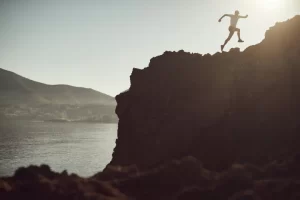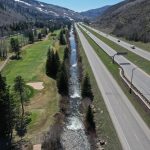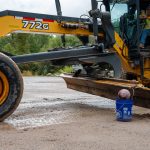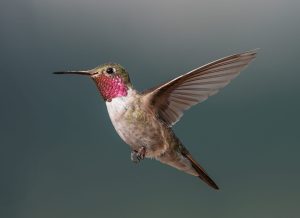Report details factors in East Vail slide that killed one
According to the CAIC, Johnny Kuo assumed he was in a safe spot before avalanche caught him

Vail local Johnny Kuo, an experienced backcountry skier who was a regular in the East Vail Chutes, felt he was in a safe zone when he was engulfed by snow in the Feb. 4 avalanche that took his life.
That’s according to the Colorado Avalanche Information Center’s final report, released Friday, on the fatal slide.
Kuo, 41, was with another skier when she triggered the avalanche in an area known as Marvin’s West or Big Marvin, according to the report.
The pair had entered the popular sidecountry area from Vail Mountain through a backcountry access gate around 10:15 a.m. They then hiked for about 30 minutes to an area locally known as Benchmark before descending along the ridgeline to the top of a large open bowl locally known as Marvin’s West or Big Marvin.
Kuo dropped in first on Marvin’s West, which the report states is a steep, east-facing slope below treeline that is dissected by two cliff bands. After skiing through the cliff bands, Kuo stopped at a bench about 800 feet below the ridge and waited for his partner.

Support Local Journalism
The slide occurred as the second skier navigated through a narrow opening in the cliff band.
“She had skied about 300 vertical feet down to a narrow opening through a cliff band when she triggered a large avalanche that broke above her,” the report states. “She tried to escape to the trees on the skier’s right side. She managed to stay upright and came to a stop on the apron below the cliff band buried to her knees in avalanche debris.”

The skier who triggered the slide uncovered her skis and began to descend into the debris field while looking for Kuo, who was not at their planned meeting point. The avalanche had run over and well past the bench where he was supposed to be waiting, the report states.
Kuo’s skiing partner then switched her avalanche transceiver to receive and began to search. She located Kuo and began digging, reaching him below snow that was up to 3 feet deep. She cleared the snow from around his head and shoulders, which took about 10 minutes, to find Kuo wasn’t breathing.
Kuo’s partner called Vail Ski Patrol at 11:20 a.m. to report the accident, although due to poor cellular reception, the ski patrol dispatcher couldn’t understand all of the call other than that there had been an avalanche accident in East Vail.
A trio of nearby skiers in the area who had seen Kuo and his partner earlier came to help after hearing Kuo’s partner calling for assistance. All four helped dig Kuo out of the snow. The group conducted CPR for about an hour but were unable to resuscitate Kuo.
Kuo was eventually taken down the mountain, via toboggan, by ski patrollers who reached the site before transporting him to authorities at Interstate 70.
“This was a soft slab avalanche unintentionally triggered by a skier,” the report states. “It was medium-size relative to the path and produced enough destructive force to bury, injure, or kill a person. It broke into old snow layers. The avalanche broke about 2 to 3 feet deep, 700 feet wide, and ran about 1000 vertical feet.”
A skier, a photographer and a traveler
Locals who knew Kuo remembered him as a unique personality in Vail, a fast, silent, light-on-his-feet skier who dressed in all black who earned the nickname “The Ninja” for his style.
The son of Taiwanese immigrants, Kuo grew up on the East Coast before making his way out to Colorado to attend the University of Colorado Boulder. He eventually moved to Vail where he became well-known in backcountry skiing circles.
He was also an accomplished photographer who had done plenty of globetrotting and always had great recommendations for friends seeking adventure. He was also a regular at The George in Vail, a favorite ski town haunt among locals where he earned a reputation as a phenomenal pool player.

“I can confidently say John died doing exactly what he loved most,” Johnny’s sister, Caroline Kuo, told the Vail Daily’s John LaConte. “He wouldn’t have wanted to die any other way than on that mountain, in the beautiful majesty of that snow and that mountain, having just done a run.”
Avalanche danger remains high
Kuo’s death came just days after three other Eagle County locals were killed in a massive slide in the San Juan Mountains after getting caught in what the CAIC’s final report on the incident called a “terrain trap.”
The backcountry danger remains high, with the CAIC on Friday sharing a “statewide special advisory” video where Executive Director Ethan Greene described how this season’s snowpack “is a different beast.”
Greene said conditions haven’t been this bad since 2012, adding “if you’ve been recreating in the Colorado backcountry for 20 years, this may be the second time you’ve seen these conditions.”
Greene said this year’s slides are running wider than you’d expect and crossing multiple terrain features — in some cases running the full length and width of avalanche paths. Greene said this effectively means the routes backcountry recreators are used to taking may not keep them safe this year.
Greene’s comments come after the deadliest week for recreational avalanche accidents in the country’s history. There were 15 fatalities across the country last week. As of Friday, there have been eight avalanche fatalities in Colorado this season, more than the year-long average of six. Greene said all of the state’s fatalities were men between the ages of 40-69, were passionate mountain athletes who had spent a lot of time recreating in the backcountry and were residents and integral parts of mountain towns for years.
Antonio Olivero of the Summit Daily News contributed reporting










